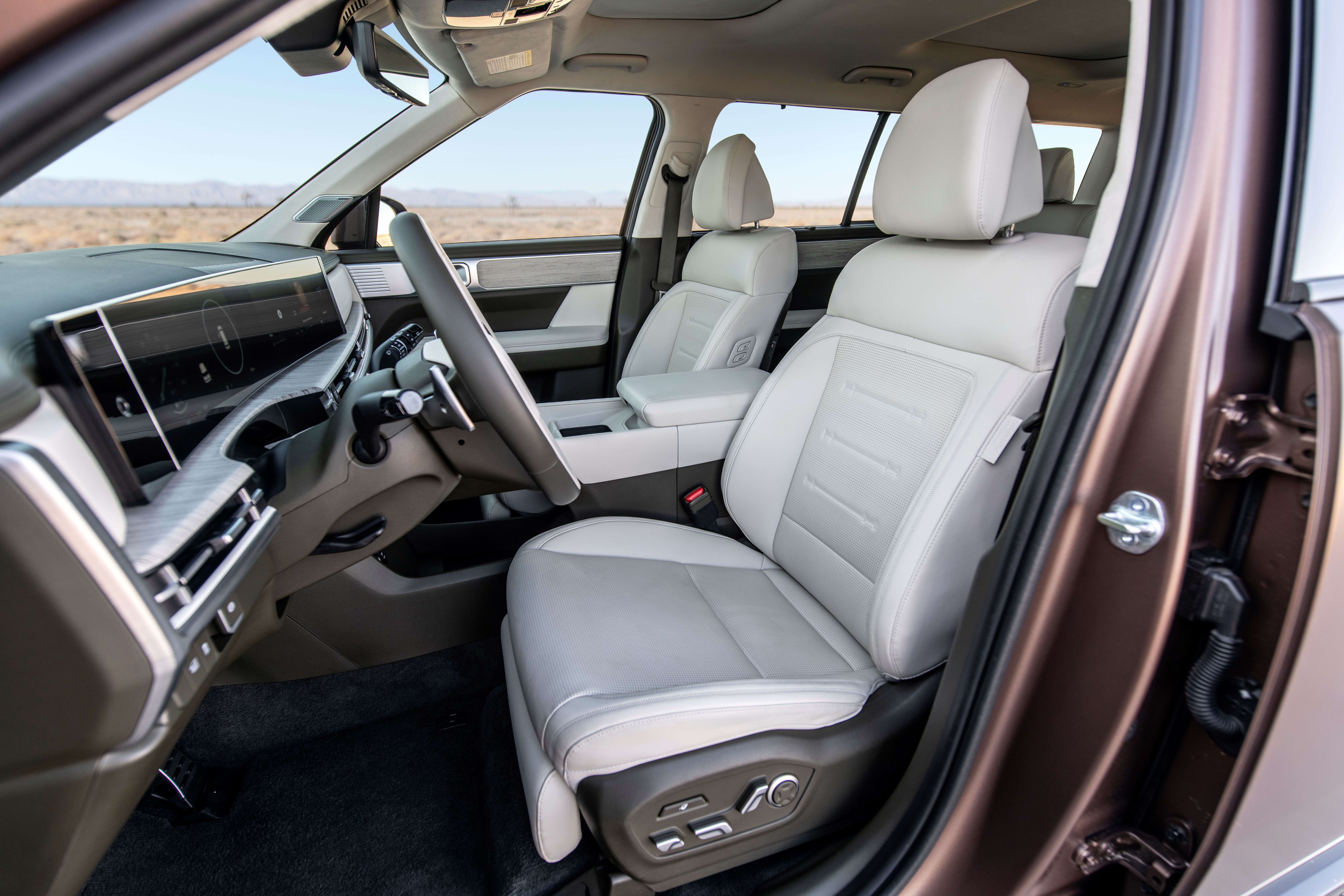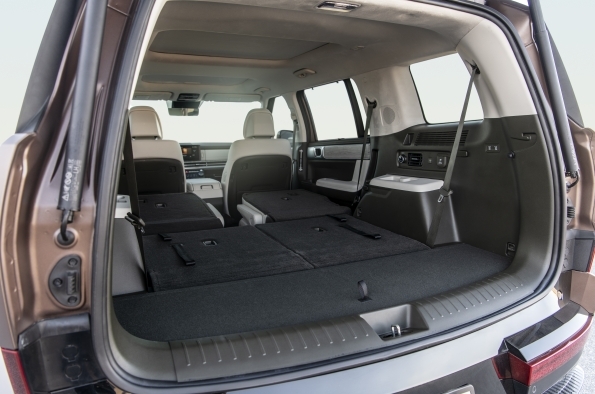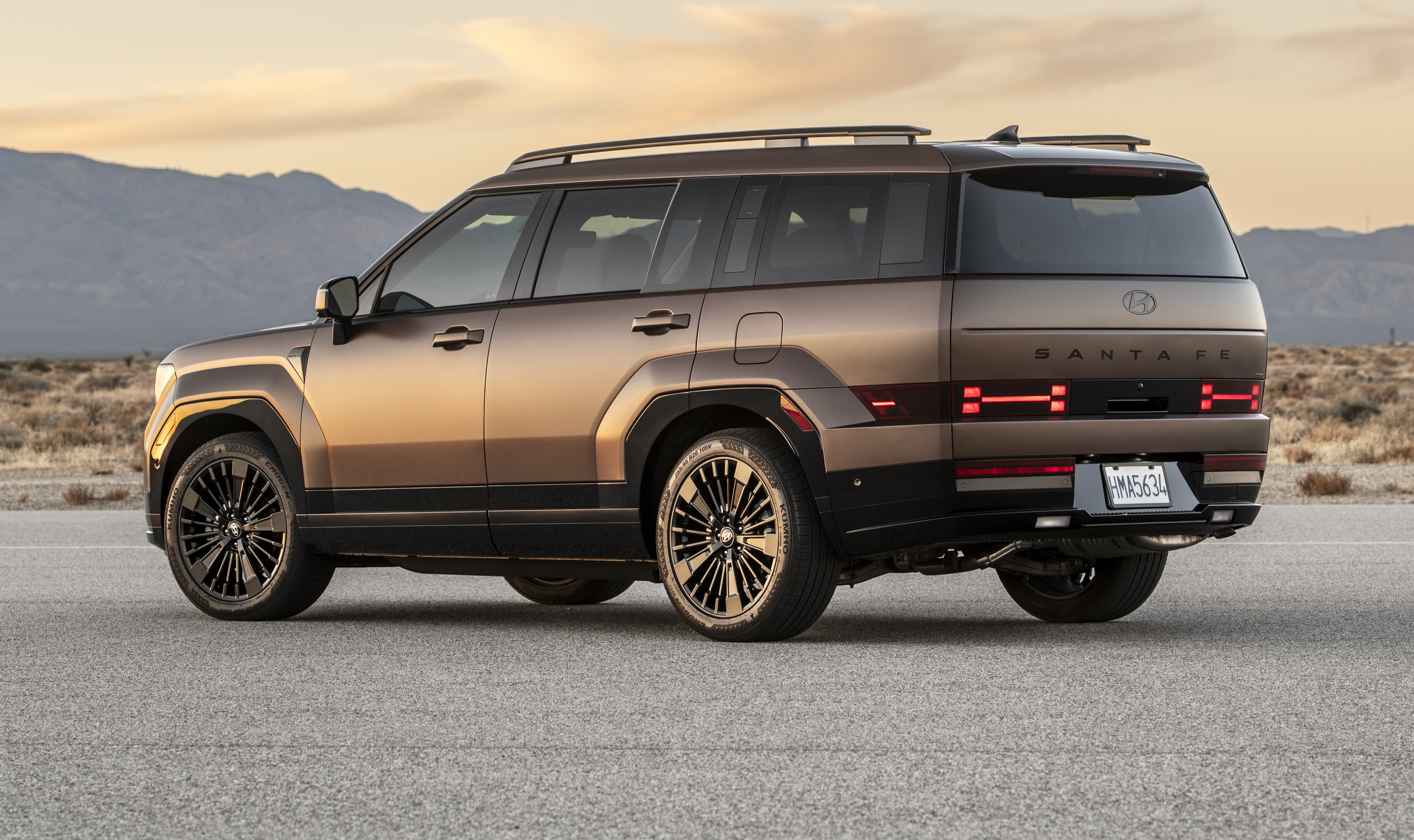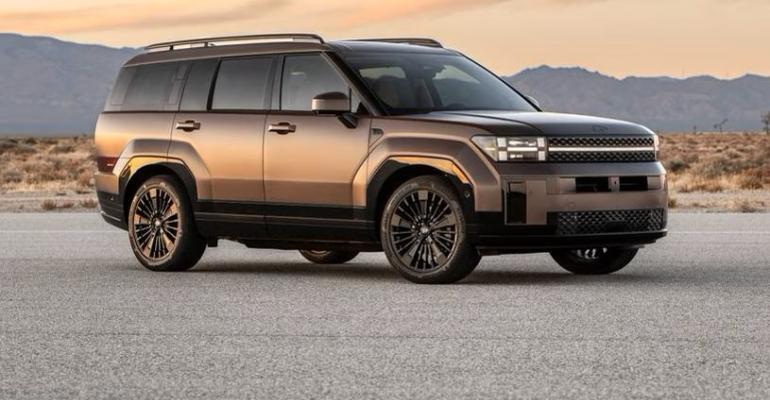FRANKLIN, TN – Not long ago, SUVs were mostly big, full-frame, rear-wheel-drive (or 4x4) truck-based boxes on wheels. Think Chevrolet Tahoe and Suburban, Ford Expedition, et al. Then came increasing varieties of mostly smaller, front- (or all-wheel-) drive, unibody, tall-wagon, car-based “crossovers,” which have become dominant in nearly all sizes and segments. Now also commonly called SUVs, most sport somewhat swoopy shapes (and are usually categorized as CUVs in Wards segmentation). Think today’s Chevy Blazer, Ford Escape and most any modern Mazda CUV. They may look good but typically offer less rear room and cargo capacity than same-size SUV boxes.
But that swoopy CUV trend is reversing in some brands’ stables, especially with the all-new ’24 Hyundai Santa Fe. Following what the South Korean automaker calls an “Open for More” concept, it boasts a more spacious interior with standard 3-row seating inside its new 2-box shape on a longer wheelbase despite its “compact” exterior size. And its much wider liftgate opening and “terrace-like” rear compartment are designed for tailgating and camping, not just storage.
“The original Santa Fe was our very first SUV in the U.S. more than two decades ago,” says José Muñoz, Hyundai Motor North America president and CEO. “Today, we have a well-recognized and respected portfolio of 14 SUV models that include internal-combustion-engine, hybrid, plug-in hybrid, electric and hydrogen-fuel-cell electric models. Our newest Santa Fe will attract even more customers with its bold, distinctive design identity, spacious interior design and unique ability to fuse urban customer lifestyles with the natural outside environment.”
Hyundai says the new Santa Fe’s design began with that “outdoor-oriented” rear space, then progressed to the rest of its space-efficient interior and exterior. Its bold new face features signature H-shaped headlamps below a taller, level hood. In profile, aggressive wheel arches and (available) 21-in. wheels complement a flatter roof and shorter front overhang, while H-shaped taillamps and that extra-wide (50.2-in. [128-cm]) liftgate opening bring up the rear. The all-new interior also follows the H-shape motif within horizontal and vertical design elements.

This fine-looking interior (pictured, above) offers a first-in-class panoramic curved display encompassing a 12.3-in. (31-cm) digital gauge cluster and infotainment system plus increased rear headroom and second- and (class-leading) third-row legroom. Both rows fold flat to create that terrace-like rear space and impressive cargo capacity: 14.6 cu.-ft. (413 L) behind the third row, 40.5 cu.-ft. (1,147 L) behind the second row and nearly 80 cu.-ft. (2,265 L) with both rows folded flat. Roof storage access is assisted by a clever, self-concealing grab handle in the exterior C-pillar.
The standard powertrain – a 277-hp, 311-lb.-ft. (422-Nm) 2.5L turbocharged 4-cyl. driving the front wheels through an 8-speed dual-clutch transmission – is good for EPA-estimated economy of 20 mpg city/29 highway (11.8-8.1 L/100 km). With AWD, that efficiency is slightly reduced to 20/28 mpg (11.8-8.4 L/100 km) and 19/26 mpg (12.4-9.0 L/100 km) for the off-road-oriented AWD XRT model. A 231-hp, 271-lb.-ft. (367-Nm) hybrid version powered by a 1.6L turbo 4-cyl. through a 6-speed automatic provides 36/35 mpg (6.5-6.7 L/100 km) economy with FWD and 35/34 mpg (6.7-6.9 L/100 km) with AWD.
The ’24 Santa Fe’s list of standard and available (mostly in top Calligraphy trim) features, some of them world or class firsts, is too long for this space, but among its highlights are:
- First-row Relaxation Comfort seat with leg rest.
- Second-row power-reclining captain’s chairs or power fold-and-dive seats with a world’s-first cushion-angle adjustment.
- UV-C ultraviolet sterilization compartment for cell phones, wallets, glasses, etc.
- Hyundai Pay, which enables paying for parking and fueling from inside the vehicle.
- Rear occupant alert, forward collision-avoidance assist, driver attention warning, forward attention warning, highway driving assist and smart parking and safe exit assist.
Making its global debut, the ’24 Santa Fe XRT enhances the Calligraphy trim “to satisfy adventure-oriented enthusiasts with confident capabilities.” It adds dark chrome and black exterior trim, plus cladding, 30-in. all-terrain tires and nearly 1.5 ins. (38 mm) of additional ground clearance. Properly equipped with a towing package, it can tow up to 4,500 lbs. (2,041 kg).

We drove a fully equipped Calligraphy model on twisty two-lanes near Nashville, TN, and judged its performance from the 2.5L turbo-4 more than adequate, including for passing. It handled well for its 2-ton-plus weight but felt a bit more like the domestic truck-based SUV it resembles than a lighter car-based CUV. Steering was precise and braking strong, linear and fade-free. We also ran a moderate off-road course in a TRX and found it handled such challenges quite well.
We found the seats were comfy all day, and the unique Relaxation Comfort driver’s seat a nice place to recline and relax. Too bad one isn’t offered for the front passenger, but that could be a crash safety issue if used while under way. Also, the instrument cluster and infotainment center has much-appreciated hard buttons for major features. The second row was roomy as promised, the third row (unsurprisingly) a bit difficult to access and tight for a 6-foot (1.8-m) adult.
It is a somewhat traditional-looking CUV box, but a pleasant-driving, visually appealing and aero-efficient one at a reported Cd of 0.294. Starting at $33,950 for the FWD SE and climbing to $48,800 for a Calligraphy AWD Hybrid (XRT price TBA), it should do quite well in the highly competitive compact CUV segment. Hyundai expects hybrids to account for 35%-40% of sales.






